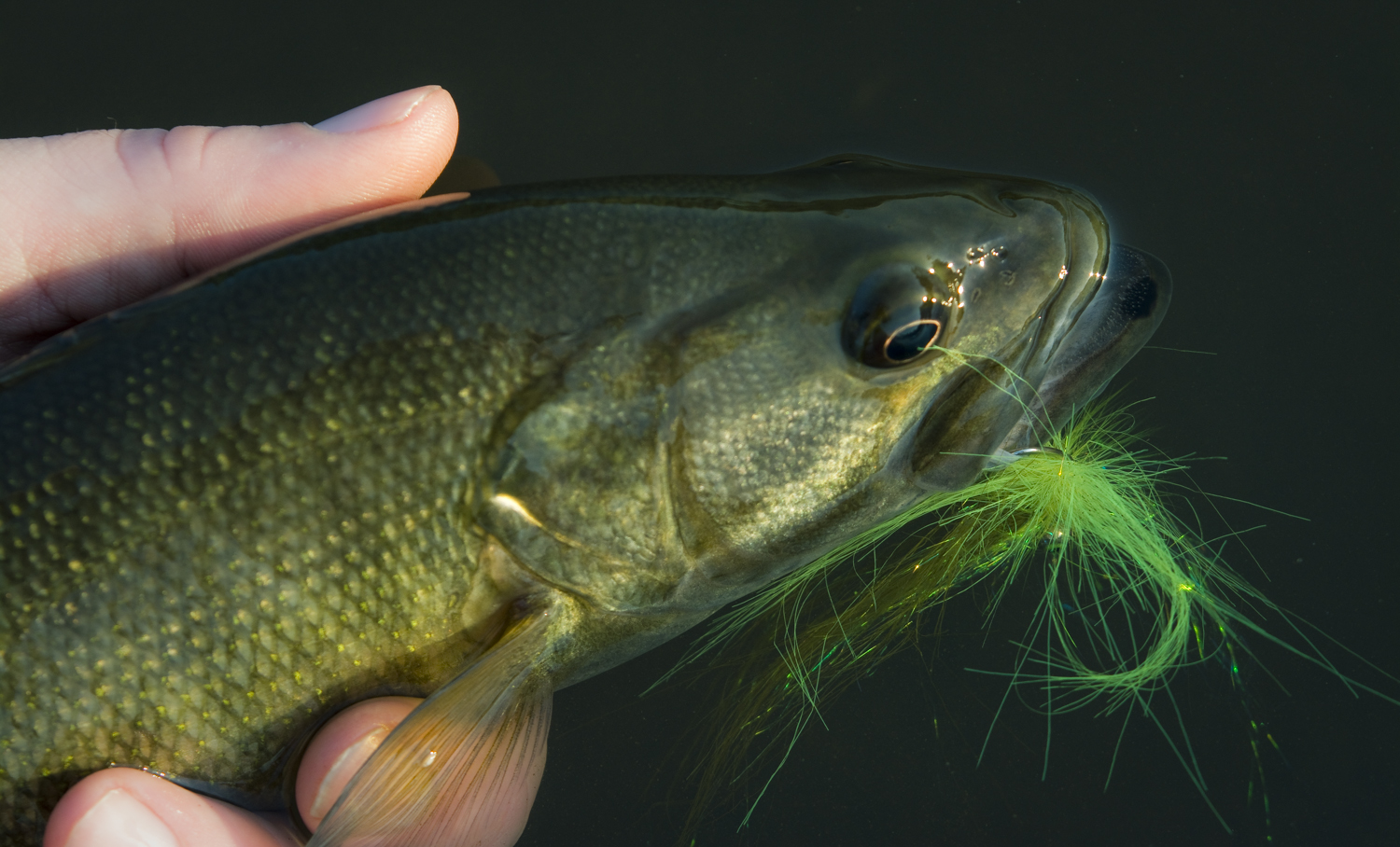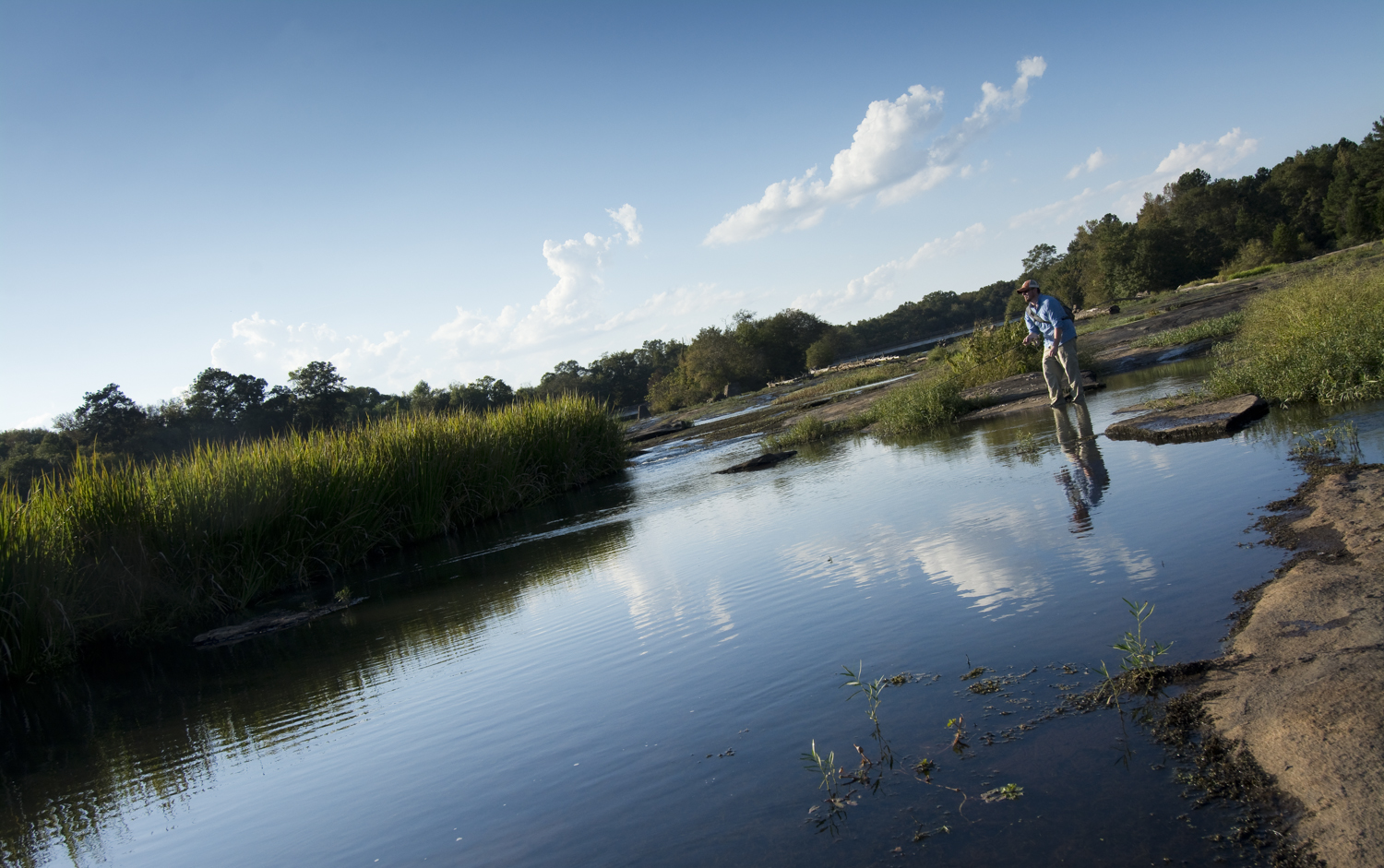By Justin Pickett
The setting sun is warm at my back as I stand at the rear of my Jeep.
I slip on my guard socks and wrench down on my boots until I’m happy with the fit. No need for waders today. The deep south humidity is smothering as I place my Buff around my neck. I dig through the mess that is my gear bag, and pull out my reel and place it on my six weight rod. I’m anxious as I slip the fly line through the guides, but I know that haste often does not lead to happiness. “Slow it down, take your time,” I remind myself.
I peer into my fly box, looking at all of its different inhabitants. Flies I’ve either bought, tied, found, or that have been gifted to me. The colors, the variety of materials. The unique purpose each pattern serves. There are several flies that have not so much as kissed the water, and a select few that have some serious frequent flyer miles. I don’t know why I stare for so long. It’s almost comical. I knew what fly I was going to fish with before I left the house.
I smirk and shake my head as I grab and inspect my go-to fly. It’s a simple fly, but a deadly one. It is a variant of an old, tried and true pattern. The materials reside around a size #4 streamer hook and are dark olive in color. The free flowing, marabou tail has just a bit of flash added to aide in piquing the interest of the fish that I seek. The body is wound with hackled feathers, and within the body are several rubbery legs, protruding from each side just before the nickel conehead. Ah, that’s where the life of this fly exists. The long, webby schlappen and the speckled tentacles breathes this fly to life. It is not prey. It is a seeker, and find, it does. My quarry just can’t seem to resist it once it is swung through their space. Add a little dash of confidence and a pinch of mojo, and how could one go wrong?
As I look over the bridge I can see fish rising, splashing at the surface each time they take a mayfly that has perilously drifted into their feeding lanes. Topwater isn’t my game plan though. The river is running at the perfect flow, just a touch high, and that’s just how I like it. I know this is going to be a great evening. The “magic hour” is approaching as I cinch down on my loop knot and hang my fly on the hook keeper. I set my drag. I grab my sling pack and clip my hemostats to the shoulder strap. I check again to make sure that I have my fly box and the few tippet spools that I need.
For those that fish within its banks, this location is endearingly known as “The Promised Land.”
It is a gorgeous example of God’s work, and its given name eludes to this fact. You just don’t expect to see something so beautiful on a river that began its life as run-off from a storm drain. However odd its origins may be, this river is teeming with wonder. Teeming with life.
An early summer afternoon can serve up suffocating clouds of emergent bug life, bringing even the most discerning of predators out to put on their feed bags. This section of the river consists of shoals, runs, and several slower pools. My target thrives in this environment. The wealth of insect life supported by the free-flowing waters, and the surrounding vegetation, keeps these fish healthy and fit.
As I skip from rock to rock, wading through the water only when necessary, I find empty carcasses of olive and orange. These little crustacean critters have fallen victim to the numerous birds and otters, and are also favorite food fare of my finned quarry. Just another reason why I know my choice of fly pattern is on point.
I crouch a little as I approach the first run. The water here is somewhat turbid, but a stealthy approach is still necessary in order to be a successful angler in this place. The rippled water runs along the banks of a small island, one of many that divides this wide section of river into numerous smaller currents. The island is lined with tall grass, small trees, and cat tails. The river with the sun starting to set behind the pines is quite a beautiful sight to behold. I’m just lucky to be here. I make a short cast, maybe twenty-five feet or so, directly across to the far seam, letting the current carry the fly downstream.
As the fly begins its swing, I make one short, abrupt strip…. Thump! My fly has hit its mark. A quick strip set and my fly rod is bent. My line comes tight and begins to dance, racing back and forth in the current, communicating the head shakes of my catch. Soon the water erupts at the surface, and I finally get to lay eyes on nothing less than a small wonder. A fine specimen, she rolls at the surface, shaking her head violently in an attempt to dislodge the fly, ideally placed in the corner of her jaw.
This dance continues only for a minute or so. I apply a little downstream side pressure as the fish finally concedes. As I bring her to hand I admire how healthy she is. The scales of greens, blacks, and white glistening in the sun as I place my thumb and forefinger on the lower jaw. Her big, red-tinted eyes staring back at me, examining the stranger that just pulled her from her home. The black, vertical banding over a dark olive backdrop is striking. What a beautiful Shoal Bass.
Only found in the Chattahoochee River drainage in southwest Georgia and the Apalachicola River in Florida, with its primary habitat being Georgia’s Flint River, the Shoal Bass has only been known as an independent species since 1999. Prior to ’99, it was thought that the Shoal Bass was just a sub-species of the Red Eye Bass, or Suwannee Bass.
While similar in many ways, there are a few distinct characteristics that distinguish Shoal Bass from other species of Black Bass. The Shoal Bass has three distinct black, lateral stripes along the face and gill plate, and typically has a black spot at the medial, posterior edge of the gill plate as well. The back of the Shoal Bass is a very dark green, or black in color and the flank is typically covered by 10-15 black, vertical bands with shorter, less distinct stripes between these bolder stripes. The IGFA describes this pattern more specifically as the “presence of 10-15 mid-lateral and 6-8 supralateral dark vertical bars along the sides.”
Another characteristic that separates the Shoal Bass from other species of Black Bass is the absence of teeth along the tongue. One last thing that makes the Shoal Bass unique to other species is their preferred environment. Shoal Bass inhabit the relatively shallow shoals and riffles of the aforementioned rivers. They depend on these shoals for the three “C’s” (Current, Cover, Cuisine), but rely on these shoals to spawn successfully as well.
This unique environment provides tons of cover around rocks and vegetation, as well as undercut banks. This micro environment also harbors the majority of their food, such as crayfish, aquatic insects, and fish. Though not considered an endangered species, it is considered a species of special concern because of its limited range, and catch and release is encouraged when fishing for the Shoal Bass. That’s why I choose to practice CPR (Catch, Photo, Release).
Despite the stressors of human encroachment, the Shoal Bass is a hearty fish, and tons of fun on a fly rod. In fact, I believe this species of fish was made for the fly angler. River-bred, tough, aerobatic, and aggressive, these Shoalies voraciously crush topwater flies, and maul subsurface patterns. They are often described as stronger and feistier than their cousins. I believe any displaced trout angler, like myself, would no doubt grow to admire these little green fish.
Many of the same techniques, tactics, presentations, and fly patterns are employed to coax them into attacking your fly. They average only a pound or so, but their aggressive nature and never-give-up fight make up for what they lack in stature, with a four or five pounder being considered a nice trophy. Several Shoal Bass over seven pounds are caught every year, and the current world record stands at 8lbs 12oz. Anyone who hasn’t had the chance to fish for Shoal Bass on the fly, or conventional gear for that matter, is truly missing out on some serious fun. I’m lucky that I have this place so close to my home. It is an amazing place, and just plain awesome to fish.
I finish admiring my great catch as I remove the fly from the mouth of my temporary captive. I place my hand under the belly as I lower her back into the current, holding her there for a while to give the taxed fish a chance to recover. A couple flips of her powerful tail, and off she goes to hunker back down in the tail of the run from where she was so rudely kidnapped. I relish the small victory of my first catch of the evening, hoping that this is a sign of things to come.
As I work my way downstream, I toss my streamer into several different runs and pools. I swing my fly with grace, followed by a frantic retrieve, picking up several more Shoalies along the way. This evening has far exceeded any realistic angler’s expectations. The river has been good to me this evening…too good. I try to think of what I’ve done that has pleased the fishing gods and earned me such a great experience on the water.
But not so fast. I hear a rumble over my shoulder. An evening thunderstorm has me in its sights. And as if to say “that’s enough”, a bolt of lightning splits the distant sky. A little bummed, but well satisfied, I cut my fly off and hook it into the brim of my hat. I reel up all of my fly line and break down my rod. Hopping across the rocks, back to the trail, wearing a Cheshire grin. I toss my gear into the back of my Jeep and step back into my sandals. As I drive over the bridge I stop and look back over the shoals as the sun makes its decent and the light begins to fade. I couldn’t have asked for a better evening out on the water.
Justin Pickett Gink & Gasoline www.ginkandgasoline.com hookups@ginkandgasoline.com Sign Up For Our Weekly Newsletter!


Great article. Grew up fishing creeks in Lynchburg Tennessee and have been anxious to return to those same creeks that Bill Dance fished as a boy and sling a fly. This article motivates me. Thanks
Great read! Down on the Ocmulgee we have been catching some healthy ones. It’s been exciting!!